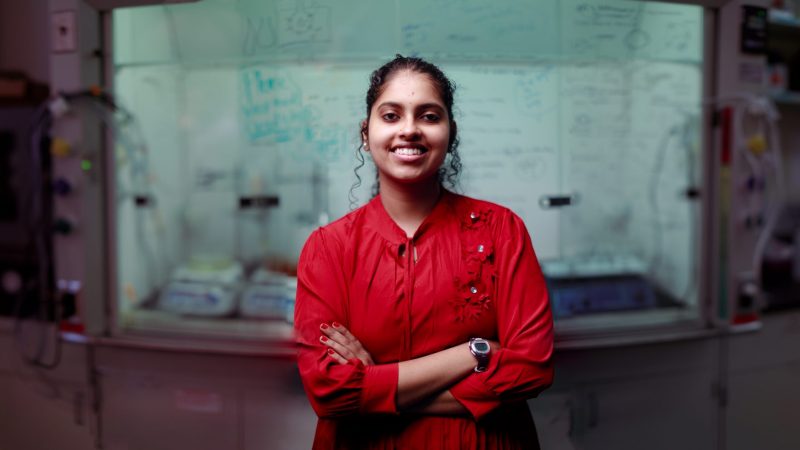
Shaping the Future with Sandhiya Thiagarajan
- July 21st, 2022
- in News

“What if I told you concepts in Marvel movies can exist today?”
These are the first words out of Sandhiya Thiagarajan’s mouth when asked about her cutting-edge research with Dr. Amanda Koh, Assistant Professor for chemical and biological engineering. Sandhiya, originally from the beach town of Chennai, Tamil Nadu, India, first met Dr. Koh in 2019 at a recruiting event in her home country.
Drawn to Dr. Koh’s influential passion for women in STEM, Sandhiya left the gorgeous beaches, temples, culture and home to pursue a PhD from The University of Alabama under Dr. Koh’s mentorship.
Dr. Koh operates the Koh Laboratory, a laboratory in the illustrious Shelby Hall named in her likeness. The Koh Laboratory focuses on engineering soft materials and material interfaces to enable new stretchable electronics, soft robotics, smart devices and porous materials. The lab emphasizes that as the needs and applications of devices in these areas become more complex and advanced, it is no longer enough to rely on single-function, bulk materials. By harnessing the unique capabilities provided by interfaces, the Koh Laboratory designs smart, responsive, multifunctional materials that are key to creating robust, practical and adaptive systems.
True to the nature of the Koh Laboratory, Sandhiya focuses on saving lives through her research of magnetic smart liquids. Suspended in an oil-like substance, these revolutionary liquids harden into a dense, peanut-butter-like material when activated and reset back to their original form when not in use. The odd traits of smart liquids make them seem other-worldly, or even out of a Marvel Movie. The goal of Sandhiya’s research is to find a way to make smart liquids stable and rust-free for longer so they can be used for stabilizing buildings during earthquakes.
Sandhiya’s research is particularly interesting considering India’s history with earthquakes. Just last year, Chennai, India was hit by an earthquake which is just one in a long line of earthquakes that have hit India ranging from devastating to relatively minor. India sits on a tectonic plate which leads to a high frequency and intensity of earthquakes, but earthquakes wreak havoc globally with very few recent inventions to prevent structural damage.
Because of Dr. Koh and The University of Alabama, Sandhiya could revolutionize earthquake protection. The liquids have been around since the early 2000s. The magnetorheological fluids
can be found in the suspension of the 2002 model of the Cadillac Seville STS and more recently, in the suspension of the second-generation Audi TT. Many have theorized that using these fluids for earthquakes as a damper system would work, but the scale and staying power that Sandhiya is moving towards could soon make that dream a reality. Sandhiya has published two research papers alongside Dr. Koh during her tenure on campus that focus on her research on magnetorheological fluids.
“They should be in the building for 10-20 years.” she mentioned, “I cannot walk in and say, ‘please move your building because I need to change the liquid.’”

Since enrolling at The University of Alabama, Sandhiya has done nothing but rave about her experience so far. From “the best lab” she has ever worked in, to the weather and the people she’s met, Sandhiya said, “I have only experienced the best at UA. Not great, not good, the best.” She goes on to talk about the faculty and staff and mentions, “people here are so kind and want you to succeed. They are great at listening and helping you with anything you need.”
When asked about her future, Sandhiya, like many others, has not quite decided. She said, “maybe stay at UA and teach or stay close to Alabama. I love the environment here and the people so much.” She closed the conversation with a note to people interested in the University by saying “Come experience it for yourself. You’ll feel yourself at home and grow yourself here.”